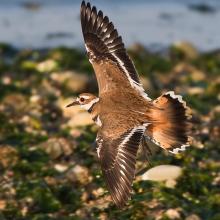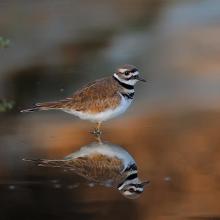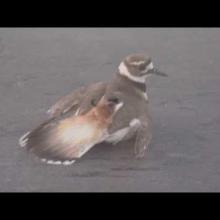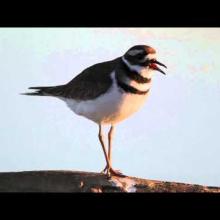

Join BirdNote tomorrow, November 30th!
Illustrator David Sibley and actor H. Jon Benjamin will face off in the bird illustration battle of the century during BirdNote's Year-end Celebration and Auction!
The cries of a Killdeer are familiar across most of the US during spring and summer. But where do they go in winter? Killdeer that breed in the southern half of the US and along the Pacific Coast are year-round residents. But those that breed in the northern US and Canada, where winter conditions are more severe, migrate south to Mexico and Central America. Because the northern Killdeer fly south — right over the region where other Killdeer reside year-round — they are known as leap-frog migrants.
BirdNote®
Partial Migration: Killdeer Play Leap-frog
Written by Bob Sundstrom
This is BirdNote.
[Killdeer contact call, http://macaulaylibrary.org/audio/191144]
The rhythmic cries of a Killdeer are familiar across most of the country in spring and summer. It’s our most often seen plover, the one with the double dark breast-bands. [Killdeer call, http://macaulaylibrary.org/audio/191144]
But what do Killdeer do in the winter? Do they migrate south or stick around through the cold months? The answer is — they do both.
Killdeer that breed in the southern half of the US and along the Pacific Coast, where winters are moderate, are year-round residents. But the ones that breed in the northern US and Canada, where winter conditions are more severe, migrate south to Mexico and Central America. [Killdeer alarm call, http://macaulaylibrary.org/audio/118665, 0.04-.07]
Killdeer are a clearcut example of what scientists call a partial migrant: part of the species population migrates; part stays put. Birds such as swifts, where they all migrate, are known as complete migrants.
And because the northern Killdeer fly south right over the region where other Killdeer reside year round, they are also known as leap-frog migrants. In spring, they will once again leap across the resident Killdeer, en route to northern zones. [Killdeer contact call, http://macaulaylibrary.org/audio/191144, 0.08-.09]
For BirdNote I’m Mary McCann.
###
Bird sounds provided by The Macaulay Library of Natural Sounds at the Cornell Lab of Ornithology, Ithaca, New York. Kildeer recorded by W L Hershberger
BirdNote’s theme music was composed and played by Nancy Rumbel and John Kessler.
Producer: John Kessler
Executive Producer: Dominic Black
© 2015 Tune In to Nature.org November 2017/2020/2022 Narrator: Mary McCann
ID# KILL-02-2015-11-25KILL-02
Useful links: http://www.allaboutbirds.org/guide/Killdeer/lifehistory
http://people.eku.edu/ritchisong/migration.htm#diff
http://www.birdwords.co.uk/press/examples-of-copy-by-dominic-couzen/par…









